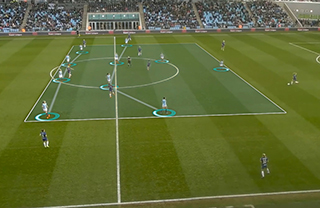
What is defending in a mid-block?
- Peter Glynn
- 19 June 2020
FA courses and webinars discuss the elite game in six phases, including defending in a low-block, mid-block and high press. Here, FA national coach developer and former Arsenal midfielder, Paul Davis, discusses the detail involved when defending in a mid-block.
What is defending in a mid-block?
A mid-block involves defending the middle section of the pitch with the purpose of preventing the opposition from playing through you.
Often this involves all the players dropping into a blocked defensive shape. The distances between the units and individuals in the block, including the goalkeeper, are quite tight in order to prevent the opposition from playing through the middle of you.
The bottom line (the last defensive line) of the mid-block is usually about 20 yards out from the 18-yard-box. That can vary from team to team, with some playing deeper, but essentially, it’s around that sort of area.
Why use a mid-block?
Not many teams can press with intensity for 90 minutes, so defending with a mid-block may be another strategy. You might be ahead in the game and want to sit back and maintain your lead, save energy and not chase around.
It might also be the first part of an attacking strategy. You might want to bring the opposition onto you in order to create space behind their backline. By encouraging the opposition onto you, there is an opportunity to exploit the space they vacate - particularly if you have quick forward players.
Another reason might be that the opposition might be strong in the centre of the pitch, with creative players at the heart of the team. So, you don’t want them to go through the middle.
There are lots of reasons why you might use a mid-block as part of your defensive strategy. But the main thing is that your players know why you’re doing it. If you give the players the why and it starts to mean something to them then, they’ll probably do it better because it has meaning.
Using the touchline as a weaponThe England DNA, which outlines the way England teams by and large play, includes the mid-block as a way of preventing teams playing through the middle of the block. It means they force the opposition in to wide areas which becomes part of a pressing strategy.
With the England teams we want to push opposition into wide areas, and then use the touchline as a weapon almost. They’ll push them wide and then try and use the line as an extra player.
How to defend in the mid-block: press or hold?
Within the mid-block you’re looking to press or to drop-off and let the opposition back four have possession - there’s no right or wrong way of doing it, it’s just a strategy the manager or the coach may want to adopt.
In the Premier League, Wolves press well in the mid-third, they rush people when they get the opportunity. They often let the opposition have the ball in their back third and won’t press too high, but in mid-press they will rush you, get up to you nice and tight and get people around in covering positions.
At the top end of the game, you also see lots of situations where teams don’t chase the opposition, they drop off, stay on their feet and their defending is controlled and not rushed.
Pressing the opposition without a strategy can be prompted by emotion and can lead to players being picked off by opposition passes - something you often see with younger players.
Decision-making in the mid-blockDefending in the mid-block can be mentally tiring. You’re constantly thinking and asking yourself: “should I go and press that ball?” “can I actually win that ball?’ or deciding if you’re not going to press. There are decisions about whether to track runners and when to pass on to others. These kinds of processes are going on all the time as the ball is being moved around.
The physical demands of moving around all the time and not getting a touch of the ball is quite a psychological challenge. Players have to be strong psychologically in order to cope with not having the ball, people running off you and deciding who you’re going to take and who you’re going to leave.
As players get older, and understand the game a bit more, they are able to deal with it more. With very young players they just want to go and get the ball.
Individual player detail

Linked to this decision-making is the detail of certain actions:
- How to press?
- Which way do you force the opposition – inside or outside?
- How do you delay an opponent?
- How do you run up to the ball?
- What is your body positioning like?
- How close do you get?
- Are you trying to win it?
Communication
At the top level, the game moves so fast it can be difficult for players to shout to somebody to do something before the ball has moved on.
In the elite game it’s about reading body movement. So, if a full-back is going out towards the ball and they are showing the opposition to the touchline, the rest of the team can see from the body position what they are doing and they should be able to react to that.
There’s simply not enough time to turn around and say “I’m going to show them the line” - it’s about cues and triggers from a player’s body shape.
To learn new skills and to enhance your technical and tactical knowledge, visit our webinar playlist on YouTube.


